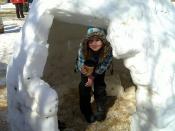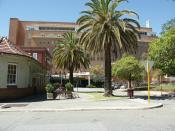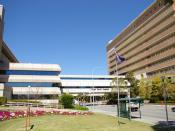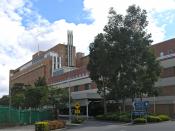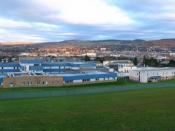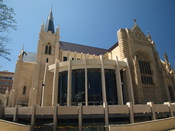Plastic surgeon Dr Fiona Wood and medical scientist Ms Marie Stoner have created a revolutionary treatment for burns victims called CellSprayî. It involves culturing the cells from a small piece of the patient's skin, and then spraying the resulting suspension onto the wound. The live skin cells quickly multiply to cover the damaged area, and the potential for scarring and infection are greatly reduced. In addition, because the covering is generated from the patient's own cells, there is almost no chance of rejection.
In 2002, CellSprayî was put to an extreme test, when Fiona led the team at Royal Perth Hospital which treated 28 victims of the Bali bombings. After Marie adapted the technology to provide the quantities of cultures demanded by the crisis, the survival and rapid recovery of almost all the severely burned patients demonstrated how effective CellSprayî had become.
Fiona, director of the West Australian Burns Unit at the Royal Perth Hospital, had long committed herself to accelerating the healing of burns victims.
Using standard skin culture techniques, grafts generally take two to three weeks to prepare. But about 75 percent of the scarring from burns remains permanent if the skin is not grafted within 10 days. So, severe scarring has always been commonplace in burns victims.
In 1993, Fiona approached Marie Stoner with an idea to set up a skin culture research laboratory. Marie already had experience in skin tissue engineering and in commercialising medical technology. In the new laboratory, she developed a technique to reduce the time for producing live skin cultures from more than two weeks to just five days. In 1995, the pair adapted this technology into CellSprayî. They also started a round-the-clock service to ensure cultures were always available to clinics.
In 1998, Fiona and Marie set up the McComb Foundation, a burns treatment research centre. Then they formed a company, Clinical Cell Culture, to commercialise their work and fund further research. Marie organised a system of product licensing and royalties, and the company, which now employs 30 staff, was listed on the Australian Stock Exchange in 2002.
CellSprayî recently was approved for use in the European Union. It also has application for treating lack of skin pigmentation and skin cancers. Clinical Cell Culture has developed a related product ReCell, a kit that can be used by a doctor in a clinic to harvest skin cells and use them on small burns or wounds.
Despite its proven use, CellSprayî is only just beginning formal testing in Australia. But while surgeons debate the technology, burns victims in Perth continue to recover faster and suffer less than ever before. In acknowledgement of her achievements with the Bali victims, Fiona Wood was named Australian of the Year for 2005.
Western Australia's only female plastic surgeon is a mother of six, Head of Royal Perth Hospital's Burns Unit and Director of the Western Australia Burns Service. She is also co-founder of Clinical Cell Culture, a private company recognised in medical circles for its world-leading research and breakthroughs in the treatment of burns. In addition, Dr Fiona Wood is also a Clinical Professor with the School of Paediatrics and Child Health at the University of Western Australia and Director of the McComb Research Foundation. She has become world renowned for her patented invention of spray on skin for burns victims, a treatment which is continually developing. Where previous techniques of skin culturing required 21 days to produce enough cells to cover major burns, Fiona has reduced that period to five days. Via her research, Fiona found that scarring is greatly reduced if replacement skin could be provided within 10 days. As a burns specialist the Holy Grail for Dr Fiona Wood is 'scarless woundless healing'. A graduate of St Thomas's Hospital Medical School in London, Fiona worked at a major British hospital before marrying Western Australian born surgeon Tony Keirath and migrating to Perth with their first two children in 1987. She completed her training in plastic surgery between having four more children. In October 2002, Fiona was propelled into the media spotlight when the largest proportion of survivors from the Bali bombings arrived at Royal Perth Hospital. She led a courageous and committed team in the fight to save 28 patients suffering from between two and 92 per cent body burns, deadly infections and delayed shock. Her exceptional leadership and surgical skills and the fact that she had the vision to plan for a large-scale disaster five years before the Bali tragedy, brought world-wide praise and recognition to the Royal Perth Hospital Burns Unit and highlighted the ground breaking research into burns treatment taking place in Western Australia. Although Fiona came into the public eye following Bali, she has been well known and respected in her field of burns internationally and locally for many years. Her business, Clinical Cell Culture, came about after a schoolteacher arrived at Royal Perth Hospital in 1992 with petrol burns to 90% of his body. Fiona turned to the emerging US-invented technology of cultured skin to save his life, working nights in a laboratory borrowed from scientist Marie Stoner. A friendship developed, and the two women joined forces to explore tissue engineering. They moved from growing skin sheets to spraying skin cells; earning a world-wide reputation as pioneers in their field. The company started operating in 1993 and is now planning to release its technology globally to use the royalties to fund further burns research. Through her enthusiasm, innovation and vision, Fiona has saved and improved countless people's lives and has inspired a nation.
BIBLIOGRAPHY:
http://www.speakersolutions.com.au/speakers/dr-fiona-wood.asp?cat=2
http://en.wikipedia.org/wiki/Fiona_Wood
